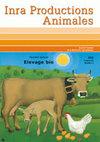在家禽饲料中使用精油。: 2。关于观察到的影响所涉及的行动模式的假设
IF 0.6
4区 农林科学
Q3 Agricultural and Biological Sciences
引用次数: 8
摘要
精油的成分可能具有多种生物活性,如抗菌、抗氧化和刺激特定受体。在动物中,它们的行动取决于它们在进食后在体内的命运,以及它们的生物目标。消化道吸收部位受多种因素调节,如饮食、化学成分、呈现形式(游离或包封)和剂量水平。根据其吸收部位的不同,它们可以在不同的水平上起作用:对于在消化道上半部分吸收的化合物,它们可以在系统水平上起作用,对于到达小肠末端的化合物,它们可以在消化内容物中起作用,直到该肠段,并在吸收后在系统水平上起作用。被吸附的产物在肝脏中发生代谢变化,然后作用于动物的各个器官。在它们被肾脏排出后,由于鸟类从尿液反流到盲肠,由精油产生的化合物可能作用于这两个盲囊。它们可以作用于消化微生物群(盲肠前或盲肠)、动物组织,也就是它们的氧化状态、免疫,特别是炎症、消化道及其消化功能,以及动物的代谢、神经系统和行为。因此,这些化合物具有很大的作用潜力,需要在未来进一步研究,以优化其使用。本文章由计算机程序翻译,如有差异,请以英文原文为准。
Utilisation des huiles essentielles en alimentation des volailles.: 2. Hypothèses sur les modes d'action impliqués dans les effets observés
The components of essential oils may have various biological activities, i.e. antimicrobial, antioxidant, and stimulant of specific receptors. In animals, their action depends on their fate in the body after feeding, and their biological targets. The absorption site along the digestive tract is modulated by various factors such as diet chemical composition, their form of presentation (free or protected by encapsulation) and dose level. Depending on their absorption site, they can act at various levels: for compounds absorbed in the upper part of the digestive tract, they can act at the systemic level, and for those attaining the end of the small intestine, they can act in digestive contents until this intestinal segment, and at the systemic level after their absorption. The adsorbed products, undergo metabolic changes in the liver, and then act on various organs of animals. After their excretion by kidneys, and due to refluxes from urine to caeca in birds, the compounds generated from essential oils may act on these two blind sacs. They can act on digestive microbiota (precaecal or caecal), animal tissues , that is on their oxidative status, immunity and particularly on inflammation, the digestive tract and its digestive functions, and on animal metabolism, nervous system and behaviour. These compounds have thus a great potential of action, which need to be further studied in the future, in order to optimise their use.
求助全文
通过发布文献求助,成功后即可免费获取论文全文。
去求助
来源期刊

Inra Productions Animales
Multiple-
CiteScore
1.30
自引率
33.30%
发文量
0
审稿时长
>36 weeks
期刊介绍:
This journal publishes scientific update reports, results of experiments and their possible applications, analyses on topical issues and presentation of research, information on scientific events and new publications.
INRA Productions Animales deals with all species of zootechnical interest (herbivores, monogastrics and fish), covering feed and nutrition, physiology, pathology, genetics, production techniques, product quality and production economics.
 求助内容:
求助内容: 应助结果提醒方式:
应助结果提醒方式:


